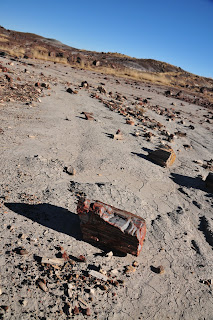Thousands of years ago during the Triassic period, there used to be trees 200 ft tall that sat along a flood plain. It took one huge flood to sweep all of the trees out of the ground.
Tossing around the trees, the water took off most branches and roots, just leaving logs to settle and rest at the bottom of the flood plain. After thousands of years of oceans and rivers brought in new sediments, layering up among the logs. Absorbing the minerals from the sediment, chemical reactions took place turning the wood into crystallized rock.
Years of rain were able to wash away the sediment and eventually exposed the wood.
This central location of petrified wood was founded and became a tourist attraction for those riding on the Santa Fe railway system.
With tourists wanting to keep a piece of the petrified wood as a souvenir, locals soon became concerned with the major disappearance of thousands of pieces of the wood.
The Petrified Forest and surrounded Painted Desert was claimed as a National Park in order to preserve the wood. The penalty for stealing rocks from the park is a 300 dollar fine and possible arrestment.
We were able to go to a few stores right outside of the park where petrified wood can be purchased. Depending on the size, color, and design of the crystals the price of the wood ranges from $5 to $16,000.
After learning about the park in the visitor center and driving through the forest it was incredible to see just how much people have destroyed the largest concentration of Petrified Wood in the world. There are only a few turnouts and a couple of short hikes that led to the petrified wood that now remains in the park. Comparing to photos from the 1800’s the difference of the amount of the logs in the park is enormous. In photos, hundreds of crystallized and colorful logs carpeted the desert. Today, you have to hike to see the parks “large” collection of a logs.
It was a really incredible park and although it was a bit out of the way, the preserved wood is exceptionally beautiful and the history of the park is truly eye opening.







































No comments:
Post a Comment